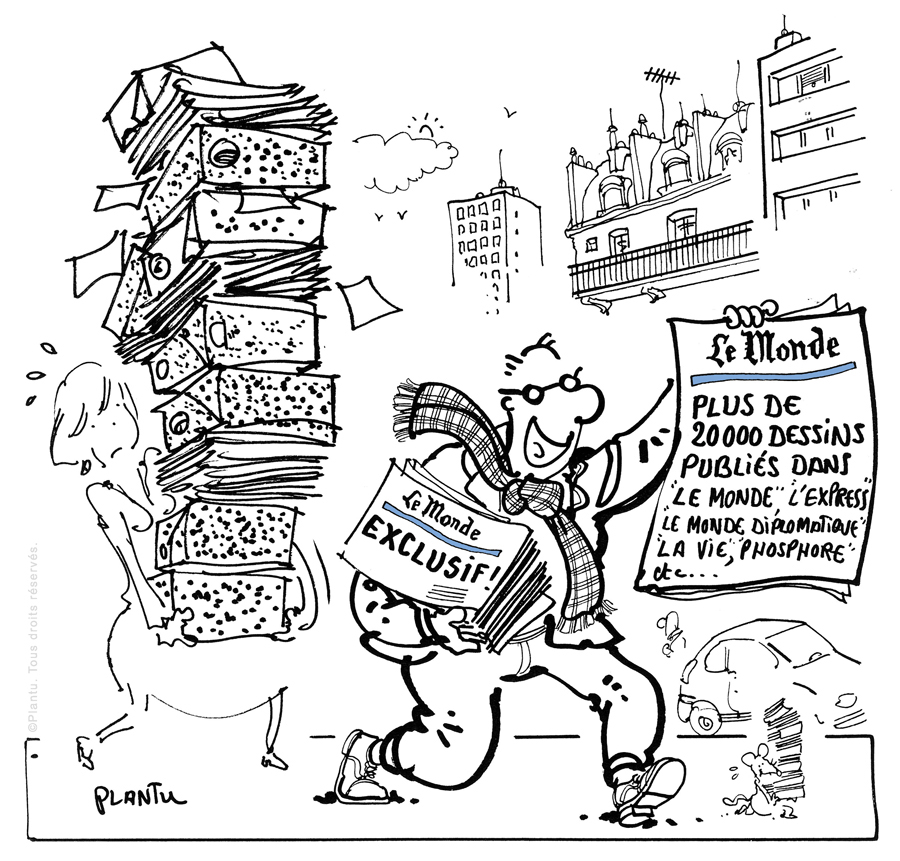
In Plantu’s Archives
In Plantu's Archives: A collection of 30 000 cartoons
By Maite Leon, personal assistant to Plantu at daily newspaper Le Monde, from October 2009 to May 2021 (Updated in 2025)
I started working at the French daily Le Monde in November 2009, and this was the beginning of a new archiving system and an eleven, almost twelve-year endeavor. These were not just any archives, but quite simply 50 years of original press cartoons drawn by Plantu, an editorial cartoonist and caricaturist at Le Monde since 1972 and with whom I had the pleasure of working, until his retirement from the newspaper, in March 2021. This is how it all starts.
On a rainy morning of winter 2009, someone from general services calls to ask me what to do with the Plantu boxes lying around in the fourth basement. On the spot, I discover, piled up in a corner, boxes filled with speckled archival boxes, scattered around, containing documents. To my great surprise, some of them are torn open and their contents are spilled out on the floor: these are not just any documents, but original ink drawings! I immediately ask that these boxes are moved to my office, which has a lock. I tell Plantu, who can’t believe it: he thought that his boxes were well protected, and not in a storage room, with all sorts of old furniture, easily accessible…
Once the boxes are safely stored in my office, I begin a brief inventory: 40 blue and green speckled cardboard boxes, each containing about 200 original ink and marker drawings, in addition to the 65 other boxes already in cabinets in my office, for a total of 21,000 drawings, according to a first estimate. On closer inspection, I notice that some of the boxes correspond to published books: they contain originals, but also copies of drawings filed in other boxes. At the time, it was easier for Plantu to find a drawing according to the book in which it was published. It becomes therefore necessary to sort the contents of all the boxes, remove all the duplicates, and refile everything according to their indexing number.
The first work of indexing the originals was carried out by Plantu himself in the 1970s and, from the 1980s, by Brigitte Rocquin, his assistant at the time. An identification number was assigned to each drawing. I will describe the archiving procedures used over the years on all of his work, both for the paper and the digital archives.
The early archives
Plantu publishes his very first drawing in La Vie du rail on September 13, 1970. In the 1970s, he also has drawings published in VRP syndicaliste, Génération, Panurge, Pourquoi pas, Pariscop, Un plus un, Bonne Soirée France and Belgique, Télé magazine and he starts working for 30 Jours d’Europe. These are mainly drawings in Indian ink executed with a very fine Rotring pen. They are stored in archival boxes labeled as follows: the number of the box, then the indexing numbers of the drawings (first and last) and, finally, the dates of publication (of the first and last drawing). In september 2019, there are 123 boxes.
In the 1980s, Plantu publishes his drawings in Témoignage chrétien, La Vie, Le Monde diplomatique, Le Monde de l’éducation, Le Monde dossiers et documents, Les Dossiers de l’étudiant, Croissance des jeunes nations, La Croix, La Mèche, Sin Censura, Réforme and Tumulte. In 1981, he publishes in Record (now Phosphore), La Non-Violence politique, Tambour, Turbule, Terre des hommes, Télérama (1983), Demain Le Monde (1984), Libération, Le Soir, La Grosse Bertha and Pèlerin magazine (1986).
He publishes his very first drawing in Le Monde, in the edition of the daily newspaper dated October 1 – 2, 1972 (fig.1). The original drawing in Indian ink is part of a donation of 500 original drawings, intended for the collection of the Department of Archives and Prints of the National Library of France (BnF).
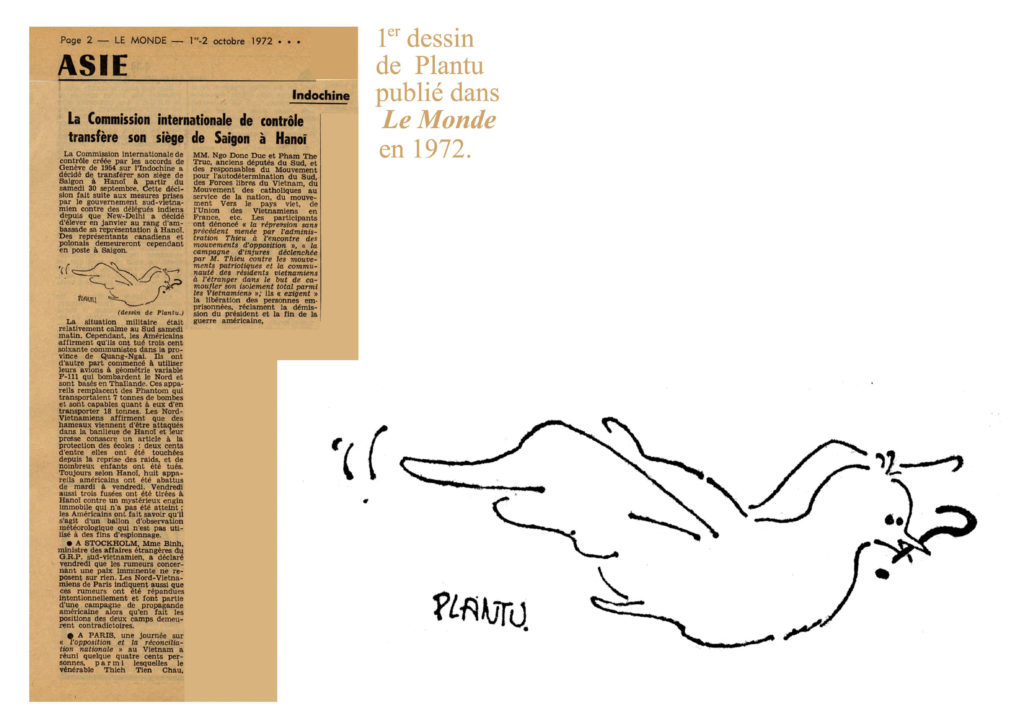
(fig.1) Plantu’s first drawing Published in Le Monde, October 2nd, 1972
The original drawings from the 1980s usually don’t have a publication date, only an index number and a few keywords. Centralizing and cross-referencing all the information in an Excel file made it possible to cross-check the data from the paper drawings and the digital images in order to identify, date and classify them in the archive boxes and in the digital files.
The 1990’s archives
Plantu publishes his first drawing in L’Express, on February 7, 1991. The first drawings published in the weekly are in black and white and the addition of color is done gradually. Plantu provided meticulous indications for the placement of colors for the photo engraving: with flat areas or vignettes with precise indications. Here is an example of an archive drawing declined as follows: the copy of the original drawing with the necessary indications (fig.2), the original drawing in ink (fig.3), a copy version colored in felt-tip pen (fig.4) and a layout template for the printmaker for the color setting (fig.5):
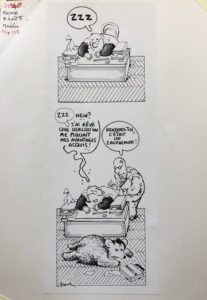
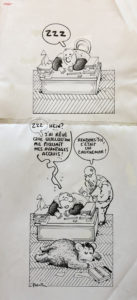
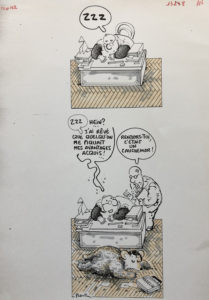
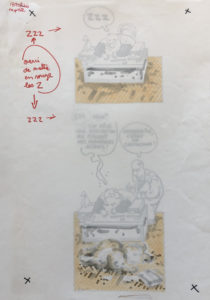
(figs.2, 3, 4, 5)
Archives in the years 2000
The format of the original drawings change, and sometimes Plantu makes a drawing in several parts: he can now scan them easily, which makes his work easier. The archived drawings have more elements: the color copy of the drawing as it was published in the press (fig.6), then the original drawing in ink in A4 or even A3 format (fig.7), drafts in black and white or color felt-tip pen (fig.8 and 9), color or black and white flat tints which are used as an indication to the printmaker for four-color printing (fig.10), as well as sometimes, a color copy of the front page of Le Monde with the drawing:
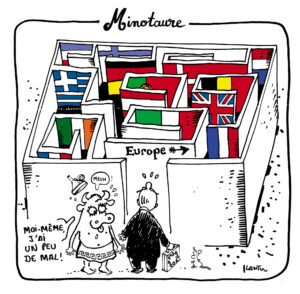
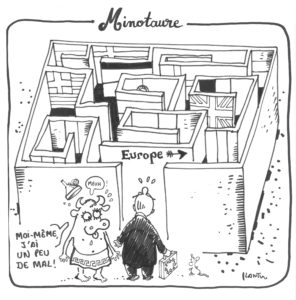
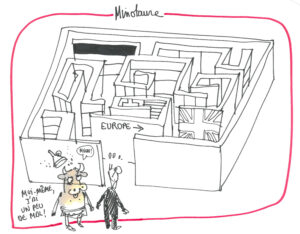
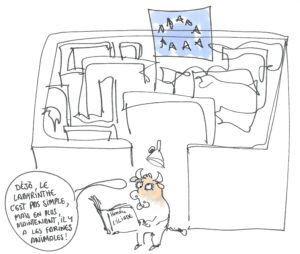
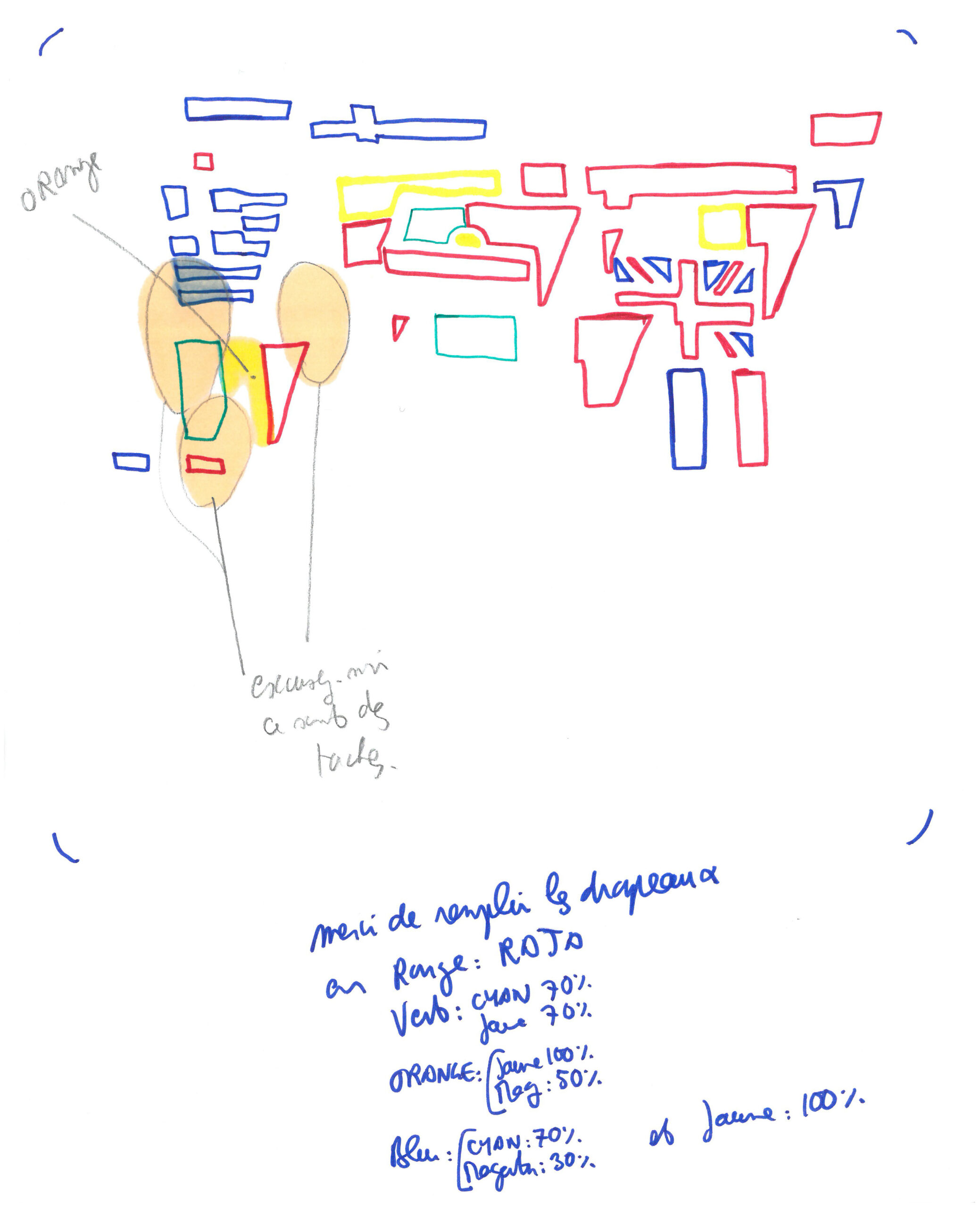
(figs.6, 7, 8, 9, 10)
The digital archives
The digital archiving of Plantu’s drawings is done in the years 2000, once the technical means make it possible. As the scans of the drawings at the time have insufficient resolution, it is necessary, starting in 2009, to rescan a large part of the collection, in particular the color versions of the drawings as they were published. Subsequently, we undertake to scan the black and white (BW) originals and the drafts from the 2000’s that exist in paper format but have never been scanned, that is to say nearly 20,000 images in JPG format at 400 dpi.
The color images in JPG format are stored on a server I shared with Plantu. This server has two main folders: a thematic folder, where each drawing is classified by theme, for example “Emmanuel Macron”, “Human Rights”, “Democracy” or “Society”, which contains 450 thematic folders and about 66,000 files (JPG drawings, PDFs, i.e. a volume of 77 GB of documents) and a chronological folder where all the drawings (without drafts) are classified by year and month, and which comprises almost 25,000 drawings.
In order to optimize the classification of the images and to harmonize their indexing, I set up a simplified system for the naming of the image files in the following form: year, month, day, theme/keywords, publication medium and the file resolution:
ex. : [21404-2018-08-21-MACRON-BENALLA-Le Monde-400.JPG]
In February 2013, I ask Odile Gaultier Voituriez, head of the archives at Sciences Po, for advice on the most efficient archival software, particularly those capable of processing images and associated metadata, in order to find the most suitable method for our internal use of Plantu’s archives. This leads me to create, at the time, an additional and complementary indexing source outside our shared server: a “NOMENCLATURE” folder which gathers all the colour JPGs, the JPGs of the originals, and the JPGs of the scanned drafts, classified by indexing number in 22 folders divided by thousands, ranging from zero to 22,000, in the following format: indexing number, year, month, day, theme/keywords, publication medium, image size:
ex. : [21027-2017-10-11-CATALOGNE-Xe-SOURIS-L’Express-600.JPG]
In 2009, I create an Excel spreadsheet that centralizes and summarizes all the data for each drawing in 11 columns as follows: index number, publication date, caption (dialogue or description of the drawing), keywords, status (published/unpublished), publication (title of the publication medium), books (in which the drawing was published), notes (various information about the drawing, whether it was given or sold, etc.), presence of the original BW (Yes/No), appendices (details about the nature of the appendices, drafts, colour plates, copies), the presence of the original BW (Yes/No), the annexes (details on the nature of the annexes, drafts, colour plates, copies). In March 2018 I add another column to list the 500 drawings donated to the BnF and, in 2019, a new column (in purple) for a precise full count of the originals.
This database, updated on a daily basis, took several years to complete. By cross-checking the data with the “Nomenclature” file, it became possible to find and correctly date up to 80% of all Plantu’s published drawings.
Press-books
Over the years, Plantu consistently listed the publications of his drawings in various media. This meticulous work allowed me to find the dates and media of publication of all his works, as well as to recreate his collection of originals by including copies of the missing drawings. This research took years and required the occasional help of interns. From 1970 to June 1972, Plantu’s drawings are filed in spiral photo albums (fig.11). He marks the date and medium of publication. The index numbers in red are added in 2018 (fig.12).
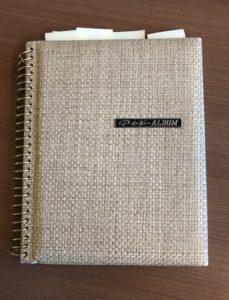
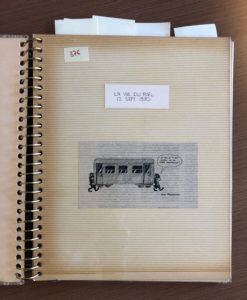
(figs.11, 12)
Later on, Plantu chooses Clairefontaine notebooks numbered from 1 to 87 in which he cuts and pastes his press articles, sometimes mentioning the date and medium of publication. The index numbers and missing dates are added in red in 2018, for indexing purposes (fig.13).

(fig.13)
From 1975 onwards, Plantu chooses stapled metal press-books, numbered from 1 to 75 and dated, which were still used in 2021 for all the press clippings (fig. 14 and 15):
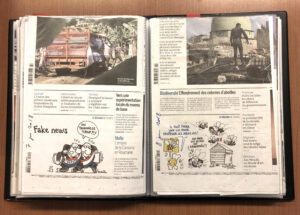
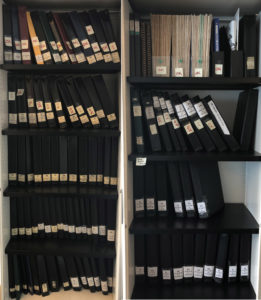
(figs.14, 15)
The tools
The tools we mainly used since I joined Le Monde in 2009, are: a XEROX and then a KONICA high-resolution printer, which enabled us to make scans and colour copies of the drawings in 400 dpi. All image processing (cropping, cleaning, file naming) was done on Photoshop, on MAC OS X and the data recording in the Excel database was done on a PC, Windows 7 Pro.
The other archives
Plantu’s archives also include his entire bibliography (more than 65 published personal collections of press cartoons, up to 2021), also listed in digital form, and the interviews. The paper versions are in the press-books, but the filmed videos and recorded broadcasts are saved on hard disk. There are also paper and digital archives of all his exhibitions, some volume works and sculptures, stored in a special room in Le Monde and after the newspaper’s relocation in 2020, on another location, along with administrative files and letters from readers.
Plantu’s work is extremely rich, as he is a very prolific cartoonist, and we felt it was essential to complete this archiving work. This enabled us to quantify, identify and find all of his publications, more than 90% of which are now in the archives.
I would like to thank all those who facilitated this work, the team from Le Monde‘s IT department, who were able to solve all our technical problems, the occasional contribution of trainees assigned by the BnF, and volunteers, who took some part in sorting and classifying the originals, in the computer processing of the images, and who helped to feed our database. We would like to thank Laurence Engel, then President of the BnF, as well as Martine Mauvieux, who was in charge of the collections of press drawings in the Department of Prints and Photography, where the entire collection is now stored. It has been a real challenge to carry out such a large-scale archival work, which we hope will be a goldmine for researchers and beneficial to future generations.
Maite Leon
More information:
• The BnF website
• Article on Franceinfo Culture (in French)
• Plantu’s Interview on Europe 1 (in French):

